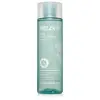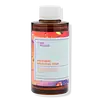What's inside
What's inside
 Key Ingredients
Key Ingredients

 Benefits
Benefits

 Concerns
Concerns

No concerns
 Ingredients Side-by-side
Ingredients Side-by-side

Water
Skin ConditioningHamamelis Virginiana Water
AstringentLavandula Intermedia Flower/Leaf/Stem Extract
MaskingNiacinamide
SmoothingGlycerin
HumectantGlycolic Acid
BufferingPolyglyceryl-10 Laurate
Skin ConditioningPanthenol
Skin ConditioningSodium Benzoate
MaskingSodium PCA
HumectantCitrus Limon Fruit Extract
MaskingPassiflora Edulis Fruit Extract
Skin ConditioningButylene Glycol
HumectantSodium Hydroxide
BufferingBeta Vulgaris Root Extract
Skin ConditioningDisodium EDTA
Hydrolyzed Corn Starch
HumectantLens Esculenta Seed Extract
Skin ProtectingCitrus Aurantium Dulcis Oil
MaskingCucumis Sativus Fruit Extract
EmollientParfum
MaskingVitis Vinifera Seed Extract
AntimicrobialAlgae Extract
EmollientArtemisia Vulgaris Extract
Skin ConditioningMagnesium Aspartate
Skin ConditioningZinc Gluconate
Skin ConditioningBenzoic Acid
MaskingSodium Hyaluronate
HumectantCopper Gluconate
Skin ConditioningPalmitoyl Tripeptide-37
Skin ConditioningCitrus Medica Limonum Peel Extract
EmollientGlycyrrhiza Glabra Root Extract
BleachingPropanediol
SolventPhenoxyethanol
PreservativeWater, Hamamelis Virginiana Water, Lavandula Intermedia Flower/Leaf/Stem Extract, Niacinamide, Glycerin, Glycolic Acid, Polyglyceryl-10 Laurate, Panthenol, Sodium Benzoate, Sodium PCA, Citrus Limon Fruit Extract, Passiflora Edulis Fruit Extract, Butylene Glycol, Sodium Hydroxide, Beta Vulgaris Root Extract, Disodium EDTA, Hydrolyzed Corn Starch, Lens Esculenta Seed Extract, Citrus Aurantium Dulcis Oil, Cucumis Sativus Fruit Extract, Parfum, Vitis Vinifera Seed Extract, Algae Extract, Artemisia Vulgaris Extract, Magnesium Aspartate, Zinc Gluconate, Benzoic Acid, Sodium Hyaluronate, Copper Gluconate, Palmitoyl Tripeptide-37, Citrus Medica Limonum Peel Extract, Glycyrrhiza Glabra Root Extract, Propanediol, Phenoxyethanol
Water
Skin ConditioningGlycerin
HumectantNiacinamide
Smoothing1,2-Hexanediol
Skin ConditioningPropanediol
SolventArbutin
AntioxidantBetaine
HumectantGlycyrrhiza Glabra Root Extract
Bleaching3-O-Ethyl Ascorbic Acid
Skin ConditioningEthylhexylglycerin
Skin ConditioningCarbomer
Emulsion StabilisingTromethamine
BufferingTrisodium Ethylenediamine Disuccinate
Theobroma Cacao Seed Extract
AntioxidantSodium Hyaluronate
HumectantDextrin
AbsorbentTocopherol
Antioxidant
 Reviews
Reviews

Ingredients Explained
These ingredients are found in both products.
Ingredients higher up in an ingredient list are typically present in a larger amount.
Glycerin is already naturally found in your skin. It helps moisturize and protect your skin.
A study from 2016 found glycerin to be more effective as a humectant than AHAs and hyaluronic acid.
As a humectant, it helps the skin stay hydrated by pulling moisture to your skin. The low molecular weight of glycerin allows it to pull moisture into the deeper layers of your skin.
Hydrated skin improves your skin barrier; Your skin barrier helps protect against irritants and bacteria.
Glycerin has also been found to have antimicrobial and antiviral properties. Due to these properties, glycerin is often used in wound and burn treatments.
In cosmetics, glycerin is usually derived from plants such as soybean or palm. However, it can also be sourced from animals, such as tallow or animal fat.
This ingredient is organic, colorless, odorless, and non-toxic.
Glycerin is the name for this ingredient in American English. British English uses Glycerol/Glycerine.
Learn more about GlycerinGlycyrrhiza Glabra Root Extract is an extract of the roots of Licorice. It has been found to have several benefits such as skin hydrating, conditioning, and soothing.
One component, glabridin, has extra potent antioxidant and soothing properties. It has also been found to block pigmentation from UVB rays in guinea pigs.
Licorice Root also contains a flavonoid. Flavonoids are a natural substance from in plants. Flavonoids also have antioxidant properties.
Another component, glycyrrhizin, has been found to have anti-inflammatory and antimicrobial benefits. This may make licorice root extract effective at treating acne. However, more research is needed to support this.
Liquiritin is one of the flavone compounds found in licorice. It has been found to help lighten skin by preventing tyrosinase from reacting with tyrosine. When the two react, protein is converted to melanin. Melanin is the substance in your body that gives your features pigmentation.
Learn more about Glycyrrhiza Glabra Root ExtractNiacinamide is a multitasking form of vitamin B3 that strengthens the skin barrier, reduces pores and dark spots, regulates oil, and improves signs of aging.
And the best part? It's gentle and well-tolerated by most skin types, including sensitive and reactive skin.
You might have heard of "niacin flush", or the reddening of skin that causes itchiness. Niacinamide has not been found to cause this.
In very rare cases, some individuals may not be able to tolerate niacinamide at all or experience an allergic reaction to it.
If you are experiencing flaking, irritation, and dryness with this ingredient, be sure to double check all your products as this ingredient can be found in all categories of skincare.
When incorporating niacinamide into your routine, look out for concentration amounts. Typically, 5% niacinamide provides benefits such as fading dark spots. However, if you have sensitive skin, it is better to begin with a smaller concentration.
When you apply niacinamide to your skin, your body converts it into nicotinamide adenine dinucleotide (NAD). NAD is an essential coenzyme that is already found in your cells as "fuel" and powers countless biological processes.
In your skin, NAD helps repair cell damage, produce new healthy cells, support collagen production, strengthen the skin barrier, and fight environmental stressors (like UV and pollution).
Our natural NAD levels start to decline with age, leading to slower skin repair, visible aging, and a weaker skin barrier. By providing your skin niacinamide, you're recharging your skin's NAD levels. This leads to stronger, healthier, and younger looking skin.
Another name for vitamin B3 is nicotinamide. This vitamin is water-soluble and our bodies don't store it. We obtain Vitamin B3 from either food or skincare. Meat, fish, wheat, yeast, and leafy greens contain vitamin B3.
The type of niacinamide used in skincare is synthetically created.
Learn more about NiacinamidePropanediol is an all-star ingredient. It softens, hydrates, and smooths the skin.
It’s often used to:
Propanediol is not likely to cause sensitivity and considered safe to use. It is derived from corn or petroleum with a clear color and no scent.
Learn more about PropanediolSodium Hyaluronate is hyaluronic acid's salt form. It is commonly derived from the sodium salt of hyaluronic acid.
Like hyaluronic acid, it is great at holding water and acts as a humectant. This makes it a great skin hydrating ingredient.
Sodium Hyaluronate is naturally occurring in our bodies and is mostly found in eye fluid and joints.
These are some other common types of Hyaluronic Acid:
Learn more about Sodium HyaluronateWater. It's the most common cosmetic ingredient of all. You'll usually see it at the top of ingredient lists, meaning that it makes up the largest part of the product.
So why is it so popular? Water most often acts as a solvent - this means that it helps dissolve other ingredients into the formulation.
You'll also recognize water as that liquid we all need to stay alive. If you see this, drink a glass of water. Stay hydrated!
Learn more about Water